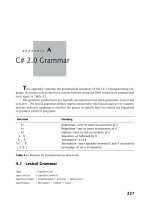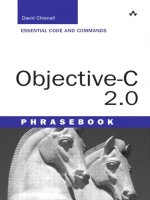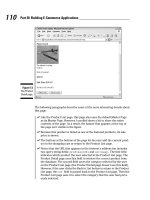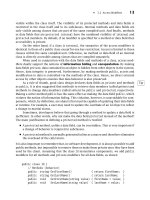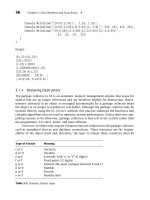Praise for C# 2.0: Practical Guide for Programmers 2005 phần 4 pdf
Bạn đang xem bản rút gọn của tài liệu. Xem và tải ngay bản đầy đủ của tài liệu tại đây (370.37 KB, 22 trang )
■
4.3 Literals 63
4.3 Literals
The C# language has six literal types: integer, real, boolean, character, string, and null.
Integer literals represent integral-valued numbers. For example:
123 (is an integer by default)
0123 (is an octal integer, using the prefix 0)
123U (is an unsigned integer, using the suffix U)
123L (is a long integer, using the suffix L)
123UL (is an unsigned long integer, using the suffix UL)
0xDecaf (is a hexadecimal integer, using the prefix 0x)
Real literals represent floating-point numbers. For example:
3.14 .1e12 (are double precision by default)
3.1E12 3E12 (are double precision by default)
3.14F (is a single precision real, using the suffix F)
3.14D (is a double precision real, using the suffix D)
3.14M (is a decimal real, using the suffix M)
Suffixes may be lowercase but are generally less readable, especially when making the
Tip
distinction between the number 1 and the letter l. The two boolean literals in C# are
represented by the keywords:
true false
The character literals are the same as those in C but also include the Unicode characters
(\udddd):
\ (continuation) ‘\n’ ‘\t’ ‘\b’ ‘\r’ ‘\f’ ‘\\’ ‘\’’ ‘\"’
0ddd or \ddd
0xdd or \xdd
0xdddd or \udddd
Therefore, the following character literals are all equivalent:
‘\n’ 10 012 0xA \u000A \x000A
String literals represent a sequence of zero or more characters—for example:
"A string"
"" (an empty string)
"\"" (a double quote)
Finally, the null literal is a C# keyword that represents a null reference.
64 Chapter 4: Unified Type System
■
4.4 Conversions
In developing C# applications, it may be necessary to convert or cast an expression of
one type into that of another. For example, in order to add a value of type float to a
value of type int, the integer value must first be converted to a floating-point number
before addition is performed. In C#, there are two kinds of conversion or casting: implicit
and explicit. Implicit conversions are ruled by the language and applied automatically
without user intervention. On the other hand, explicit conversions are specified by the
developer in order to support runtime operations or decisions that cannot be deduced by
the compiler. The following example illustrates these conversions:
1 // ‘a’ is a 16-bit unsigned integer.
2 int i = ‘a’; // Implicit conversion to 32-bit signed integer.
3 char c = (char)i; // Explicit conversion to 16-bit unsigned integer.
4
5 Console.WriteLine("i as int = {0}", i); // Output 97
6 Console.WriteLine("i as char = {0}", (char)i); // Output a
The compiler is allowed to perform an implicit conversion on line 2 because no information
is lost. This process is also called a widening conversion, in this case from 16-bit to 32-bit.
The compiler, however, is not allowed to perform a narrowing conversion from 32-bit to
16-bit on line 3. Attempting to do charc=i;will result in a compilation error, which
states that it cannot implicitly convert type int to type char. If the integer i must be
printed as a character, an explicit cast is needed (line 6). Otherwise, integer i is printed
as an integer (line 5). In this case, we are not losing data but printing it as a character,
a user decision that cannot be second-guessed by the compiler. The full list of implicit
conversions supported by C# is given in Table 4.4.
From To Wider Type
byte decimal, double, float, long, int, short, ulong, uint, ushort
sbyte decimal, double, float, long, int, short
char decimal, double, float, long, int, ulong, uint, ushort
ushort decimal, double, float, long, int, ulong, uint
short decimal, double, float, long, int
uint decimal, double, float, long, ulong
int decimal, double, float, long
ulong decimal, double, float
long decimal, double, float
float double
Table 4.4: Implicit conversions supported by C#.
■
4.4 Conversions 65
Conversions from int, uint, long,orulong to float and from long or ulong to double
may cause a loss of precision but will never cause a loss of magnitude. All other implicit
numeric conversions never lose any information.
In order to prevent improper mapping from ushort to the Unicode character set, the
former cannot be implicitly converted into a char, although both types are unsigned 16-bit
integers. Also, because boolean values are not integers, the bool type cannot be implicitly
or explicitly converted into any other type, or vice versa. Finally, even though the decimal
type has more precision (it holds 28 digits), neither float nor double can be implicitly
converted to decimal because the range of decimal values is smaller (see Table 4.3).
To store enumeration constants in a variable, it is important to declare the variable as
the type of the enum. Otherwise, explicit casting is required to convert an enumerated value
to an integral value, and vice versa. In either case, implicit casting is not done and gener-
ates a compilation error. Although explicit casting is valid, it is not a good programming
practice and should be avoided.
Tip
DeliveryAddress da1;
int da2;
da1 = DeliveryAddress.Home; // OK.
da2 = da1; // Compilation error.
da2 = (int)da1; // OK, but not a good practice.
da1 = da2; // Compilation error.
da1 = (DeliveryAddress)da2; // OK, but not a good practice.
Implicit or explicit conversions can be applied to reference types as well. In C#, where
classes are organized in a hierarchy, these conversions can be made either up or down
the hierarchy, and are known as upcasts or downcasts, respectively. Upcasts are clearly
implicit because of the type compatibility that comes with any derived class within the
same hierarchy. Implicit downcasts, on the other hand, generate a compilation error since
any class with more generalized behavior cannot be cast to one that is more specific and
includes additional methods. However, an explicit downcast can be applied to any ref-
erence but is logically correct only if the attempted type conversion corresponds to the
actual object type in the reference. The following example illustrates both upcasts and
downcasts:
1 public class TestCast {
2 public static void Main() {
3 object o;
4 string s = "Michel";
5 double d;
6
7 o = s; // Implicit upcast.
8 o = (object)s; // Explicit upcast (not necessary).
9 s = (string)o; // Explicit downcast (necessary).
10 d = (double)o; // Explicit downcast (syntactically correct) but
66 Chapter 4: Unified Type System
■
11 d *= 2.0; // throws an InvalidCastException at runtime.
12 }
13 }
An object reference o is first assigned a string reference s using either an implicit or
an explicit upcast, as shown on lines 7 and 8. An explicit downcast on line 9 is logically
correct since o contains a reference to a string. Hence, s may safely invoke any method
of the string class. Although syntactically correct, the explicit downcast on line 10 leads
to an InvalidCastException on the following line. At that point, the floating-point value
d, which actually contains a reference to a string, attempts to invoke the multiplication
method and thereby raises the exception.
4.5 Boxing and Unboxing
Since value types and reference types are subclasses of the object class, they are also
compatible with object. This means that a value-type variable or literal can (1) invoke an
object method and (2) be passed as an object argument without explicit casting.
int i = 2;
i.ToString(); // (1) equivalent to 2.ToString();
// which is 2.System.Int32::ToString()
i.Equals(2); // (2) where Equals has an object type argument
// avoiding an explicit cast such as i.Equals( (object)2 );
Boxing is the process of implicitly casting a value-type variable or literal into a reference
type. In other words, it allows value types to be treated as objects. This is done by creating
an optimized temporary reference type that refers to the value type. Boxing a value via
explicit casting is legal but unnecessary.
int i = 2;
objecto=i; //Implicit casting (or boxing).
object p = (object)i; // Explicit casting (unnecessary).
On the other hand, it is not possible to unbox a reference type into a value type without
an explicit cast. The intent must be clear from the compiler’s point of view.
object o;
short s = (short)o;
The ability to treat value types as objects bridges the gap that exists in most programming
languages. For example, a Stack class can provide push and pop methods that take and
■
4.6 The Object Root Class 67
return value and reference objects:
class Stack {
public object pop() { }
public void push(object o) { }
}
4.6 The Object Root Class
Before tackling the object root class, we introduce two additional method modifiers:
virtual and override. Although these method modifiers are defined in detail in
Chapter 7, they are omnipresent in every class that uses the .NET Framework. Therefore,
a few introductory words are in order.
A method is polymorphic when declared with the keyword virtual. Polymorphism
allows a developer to invoke the same method that behaves and is implemented differently
on various classes within the same hierarchy. Such a method is very useful when we wish
to provide common services within a hierarchy of classes. Therefore, polymorphism is
directly tied to the concept of inheritance and is one of the three hallmarks of object-
oriented technology.
4.6.1 Calling Virtual Methods
Any decision in calling a virtual method is done at runtime. In other words, during a vir-
tual method invocation, it is the runtime system that examines the object’s reference. An
object’s reference is not simply a physical memory pointer as in C, but rather a virtual
logical pointer containing the information of its own object type. Based on this informa-
tion, the runtime system determines which actual method implementation to call. Such a
runtime decision, also known as a polymorphic call, dynamically binds an invocation with
the appropriate method via a virtual table that is generated for each object.
When classes already contain declared virtual methods, a derived class may wish to
refine or reimplement the behavior of a virtual method to suit its particular specifications.
To do so, the signature must be identical to the virtual method except that it is preceded
by the modifier override in the derived class. In the following example, class D overrides
method V, which is inherited from class B. When an object of class D is assigned to the
parameter b at line 13, the runtime system dynamically binds the overridden method of
class D to b.
1 class B {
2 public virtual void V() { System.Console.WriteLine("B.V()"); }
3}
4 classD:B{
5 public override void V() { System.Console.WriteLine("D.V()"); }
6}
68 Chapter 4: Unified Type System
■
7 class TestVirtualOverride {
8 public static void Bind(B b) {
9 b.V();
10 }
11 public static void Main() {
12 Bind( new B() );
13 Bind( new D() );
14
15 new D().V();
16 }
17 }
Output:
B.V()
D.V()
D.V()
With this brief overview of the virtual and override modifiers, let us now take a
comprehensive look at the object root class.
The System.Object class is the root of all other classes in the .NET Framework. Defin-
ing a class like Id (page 30) means that it inherits implicitly from System.Object. The
following declarations are therefore equivalent:
class Id { }
class Id : object { }
class Id : System.Object { }
As we have seen earlier, the object keyword is an alias for System.Object.
The System.Object class, shown below, offers a few common basic services to all
derived classes, either value or reference. Of course, any virtual methods of System.Object
can be redefined (overridden) to suit the needs of a derived class. In the sections that
follow, the methods of System.Object are grouped and explained by category: parameter-
less constructor, instance methods, and static methods.
namespace System {
public Object {
// Parameterless Constructor
public Object();
// Instance Methods
public virtual string ToString();
public Type GetType();
public virtual bool Equals(Object o);
public virtual int GetHashCode();
protected virtual void Finalize();
■
4.6 The Object Root Class 69
protected object MemberwiseClone();
// Static Methods
public static bool Equals(Object a, Object b);
public static bool ReferenceEquals(Object a, Object b);
}
}
4.6.2 Invoking the Object Constructor
The Object() constructor is both public and parameterless and is invoked by default by all
derived classes either implicitly or explicitly. The following two equivalent declarations
illustrate both invocations of the base constructor from System.Object:
class Id {
Id() { } // Invoking Object() implicitly.
}
class Id {
Id() : base() { } // Invoking Object() explicitly.
}
4.6.3 Using Object Instance Methods
Often used for debugging purposes, the ToString virtual method returns a string that
provides information about an object. It allows the client to determine where and how
information is displayed—for example, on a standard output stream, in a GUI, through a
serial link, and so on. If this method is not overridden, the default string returns the fully
qualified type name (namespace.className) of the current object.
The GetType method returns the object description (also called the metadata) of a
Type object. The Type class is also well known as a meta-class in other object-oriented
languages, such as Smalltalk and Java. This feature is covered in detail in Chapter 10.
The following example presents a class Counter that inherits the ToString method
from the System.Object class, and a class NamedCounter that overrides it (line 11). The Main
method in the test class instantiates three objects (lines 19–21) and prints the results of
their ToString invocations (lines 23–25). In the case of the object o (line 23), System.Object
corresponds to its Object class within the System namespace. For the objects c and nc
(lines 24 and 25), Counter and NamedCounter correspond, respectively, to their classes
within the default namespace. The last three statements (lines 27–29) print the names
representing the meta-class Type of each object.
70 Chapter 4: Unified Type System
■
1 using System;
2
3 public class Counter {
4 public void Inc() { count++; }
5 private int count;
6}
7 public class NamedCounter {
8 public NamedCounter(string aName) {
9 name = aName; count = 0;
10 }
11 public override string ToString() {
12 return "Counter ‘"+name+"’ = "+count;
13 }
14 private string name;
15 private int count;
16 }
17 public class TestToStringGetType {
18 public static void Main() {
19 Object o = new Object();
20 Counter c = new Counter();
21 NamedCounter nc = new NamedCounter("nc");
22
23 Console.WriteLine(" o.ToString() = {0}", o.ToString());
24 Console.WriteLine(" c.ToString() = {0}", c.ToString());
25 Console.WriteLine("nc.ToString() = {0}", nc.ToString());
26
27 Console.WriteLine("Type of o = {0}", o.GetType());
28 Console.WriteLine("Type of c = {0}", c.GetType());
29 Console.WriteLine("Type of nc = {0}", nc.GetType());
30 }
31 }
Output:
o.ToString() = System.Object
c.ToString() = Counter
nc.ToString() = Counter ‘nc’ = 0
Type of o = System.Object
Type of c = Counter
Type of nc = NamedCounter
The virtual implementation of Object.Equals simply checks for identity-based equality
between the parameter object o and the object itself. To provide value-based equal-
ity for derived classes, the Equals method must be overridden to check that the two
objects are instantiated from the same class and are identical member by member. A good
■
4.6 The Object Root Class 71
implementation tests to see first if the parameter o is null, second if it is an alias (this),Tip
and third if it is not of the same type using the operator is.InC#, this method is not
equivalent to the operation == unless the operator is overloaded.
The GetHashCode virtual method computes and returns a first-estimate integer
hash code for each object that is used as a key in the many hash tables available in
System.Collections. The hash code, however, is only a necessary condition for equality
and therefore obeys the following properties:
1. If two objects are equal then both objects must have the same hash code.
2. If the hash code of two objects is equal then both objects are not necessarily equal.
A simple and efficient algorithm for generating the hash code for an object applies
the exclusive OR operation to its numeric member variables. To ensure that identical
hash codes are generated for objects of equal value, the GetHashCode method must be
overridden for derived classes.
The following example presents a class Counter that inherits the Equals and
GetHashCode methods from the System.Object class, and a class NamedCounter that over-
rides them (lines 14 and 25). The Main method in the test class instantiates six objects
(lines 33–38) and prints their hash codes (lines 40–45). Notice that all hash codes are
unique except for the two identical objects nc1 and nc3. All the other lines (47–56) compare
objects with themselves, null, and an instance of the class Object.
1 using System;
2
3 public class Counter {
4 public void Inc() { count++; }
5 private int count;
6}
7 public class NamedCounter {
8 public NamedCounter(string aName) { name = aName; }
9 public void Inc() { count++; }
10 public int GetCount() { return count; }
11 public override string ToString() {
12 return "Counter ‘"+name+"’ = "+count;
13 }
14 public override bool Equals(object o) {
15 if (o == null) return false;
16 if (GetHashCode() != o.GetHashCode()) return false;
17 // Is same hash code?
18 if (o == this) return true;
19 // Compare with itself?
20 if (!(o is NamedCounter)) return false;
21 // Is same type as itself?
22 NamedCounter nc = (NamedCounter)o;
23 return name.Equals(nc.name) && count == nc.count;
72 Chapter 4: Unified Type System
■
24 }
25 public override int GetHashCode() {
26 return name.GetHashCode() ˆ count; // Exclusive or.
27 }
28 private string name;
29 private int count;
30 }
31 public class TestHashCodeEquals {
32 public static void Main() {
33 Object o = new Object();
34 NamedCounter nc1 = new NamedCounter("nc1");
35 NamedCounter nc2 = new NamedCounter("nc2");
36 NamedCounter nc3 = new NamedCounter("nc1");
37 Counter c1 = new Counter();
38 Counter c2 = new Counter();
39
40 Console.WriteLine("HashCode o = {0}", o.GetHashCode());
41 Console.WriteLine("HashCode nc1 = {0}", nc1.GetHashCode());
42 Console.WriteLine("HashCode nc2 = {0}", nc2.GetHashCode());
43 Console.WriteLine("HashCode nc3 = {0}", nc3.GetHashCode());
44 Console.WriteLine("HashCode c1 = {0}", c1.GetHashCode());
45 Console.WriteLine("HashCode c2 = {0}", c2.GetHashCode());
46
47 Console.WriteLine("nc1 == null? {0}", nc1.Equals(null)?"yes":"no");
48 Console.WriteLine("nc1 == nc1? {0}", nc1.Equals(nc1) ?"yes":"no");
49 Console.WriteLine("nc1 == o? {0}", nc1.Equals(o) ?"yes":"no");
50 Console.WriteLine("nc1 == nc2? {0}", nc1.Equals(nc2) ?"yes":"no");
51 Console.WriteLine("nc1 == nc3? {0}", nc1.Equals(nc3) ?"yes":"no");
52
53 Console.WriteLine(" c1 == null? {0}", c1.Equals(null) ?"yes":"no");
54 Console.WriteLine(" c1 == c1? {0}", c1.Equals(c1) ?"yes":"no");
55 Console.WriteLine(" c1 == o? {0}", c1.Equals(o) ?"yes":"no");
56 Console.WriteLine(" c1 == c2? {0}", c1.Equals(c2) ?"yes":"no");
57 }
58 }
Output:
HashCode o = 54267293
HashCode nc1 = 1511508983
HashCode nc2 = -54574958
HashCode nc3 = 1511508983
HashCode c1 = 18643596
HashCode c2 = 33574638
nc1 == null? no
■
4.6 The Object Root Class 73
nc1 == nc1? yes
nc1 == o? no
nc1 == nc2? no
nc1 == nc3? yes
c1 == null? no
c1 == c1? yes
c1 == o? no
c1 == c2? no
The last two methods of the Object class are protected to be securely available only to
derived classes. The Finalize method when overridden is used by the garbage collector
to free any allocated resources before destroying the object. Section 9.1 illustrates how
the C# compiler generates a Finalize method to replace an explicit destructor.
The MemberwiseClone method returns a member-by-member copy of the current
object. Although values and references are duplicated, subobjects are not. This type of
cloning is called a shallow copy. To achieve a shallow (or bitwise) copy, the method
Object.MemberwiseClone is simply invoked for the current object. In this way, all the non-
static value and reference fields are copied. Although a shallow copy of a value field is
non-problematic, the shallow copy of a reference-type field does not create a duplicate
of the object to which it refers. Hence, several objects may refer to the same subobjects.
The latter situation is often undesirable and therefore, a deep copy is performed instead.
To achieve a deep copy, the method Object.Memberwiseclone is invoked for the current
object and its subobject(s).
The following example shows three classes that clearly express the impact of each
kind of cloning. The Value class contains a value-type field called v. After creating an
object v1 and incrementing its value (lines 31–32), v2 is initialized as a clone of v1 and
then incremented (lines 33–34). The first two lines of output show that the v2 object is
independent of v1, though v2 had the same value as v1 at the time of the cloning. In this
case, a shallow copy is sufficient.
The ShallowCopy class contains a reference-type field called r (line 17) that is cloned
in the same way as the Value class (compare lines 7 and 15). The object sc1 is then cre-
ated on line 39 with a reference to the object v2. In cloning sc1 into sc2 (line 40), both
objects are now pointing to the same object v2. Increasing the value of v2 and printing
objects sc1 and sc2 clearly shows that the subobject v2 is not duplicated using a shallow
copy.
Finally, the DeepCopy class also contains a reference-type field r (line 27) but with
a different implementation of the method Clone. As before, the object dc1 is created on
line 46 with a reference to object v2. In cloning dc1 into dc2 (line 47), a temporary object
reference clone of type DeepCopy is first initialized to a shallow copy of the current object
dc1 (line 23). On line 24, the subobject v2 is cloned as well. The object clone is then
returned from the method Clone and assigned to dc2. Increasing the value of v2 and print-
ing objects dc1 and dc2 shows that the reference field r of each object points to a distinct
instance of the Value class. On one hand, the object dc1 refers to v2, and on the other hand,
the object dc2 refers to a distinct instance of Value, which was created as an identical copy
74 Chapter 4: Unified Type System
■
of v2. The output illustrates the impact of creating two distinct subobjects owned by two
different objects dc1 and dc2.
1 using System;
2
3 public class Value {
4 public void Inc() { v++; }
5 public override string ToString() { return "Value("+v+")"; }
6 public object Clone() { // Shallow copy of v
7 return this.MemberwiseClone();
8}
9 private int v;
10 }
11 public class ShallowCopy {
12 public ShallowCopy(Value v){r=v;}
13 public override string ToString() { return r.ToString(); }
14 public object Clone() { // Shallow copy of r
15 return this.MemberwiseClone();
16 }
17 private Value r;
18 }
19 public class DeepCopy {
20 public DeepCopy(Value v){r=v;}
21 public override string ToString() { return r.ToString(); }
22 public object Clone() { // Deep copy of r
23 DeepCopy clone = (DeepCopy)this.MemberwiseClone();
24 clone.r = (Value)r.Clone();
25 return clone;
26 }
27 private Value r;
28 }
29 public class TestClone {
30 public static void Main() {
31 Value v1 = new Value();
32 v1.Inc();
33 Value v2 = (Value)v1.Clone();
34 v2.Inc();
35
36 Console.WriteLine("v1.ToString = {0}", v1.ToString());
37 Console.WriteLine("v2.ToString = {0}", v2.ToString());
38
39 ShallowCopy sc1 = new ShallowCopy(v2);
40 ShallowCopy sc2 = (ShallowCopy)sc1.Clone();
41 v2.Inc();
■
4.6 The Object Root Class 75
42
43 Console.WriteLine("sc1.ToString = {0}", sc1.ToString());
44 Console.WriteLine("sc2.ToString = {0}", sc2.ToString());
45
46 DeepCopy dc1 = new DeepCopy(v2);
47 DeepCopy dc2 = (DeepCopy)dc1.Clone();
48 v2.Inc();
49
50 Console.WriteLine("dc1.ToString = {0}", dc1.ToString());
51 Console.WriteLine("dc2.ToString = {0}", dc2.ToString());
52 }
53 }
Output:
v1.ToString = Value(1)
v2.ToString = Value(2)
sc1.ToString = Value(3)
sc2.ToString = Value(3)
dc1.ToString = Value(4)
dc2.ToString = Value(3)
Some important best practices can be noted from the preceding examples. It is strongly
Tip
recommended to always override the ToString method. The HashCode and Equals methods
must always be overridden
2
when you wish to compare the objects of that type in your
application. When comparing objects, first invoke the HashCode method to avoid unneces-
sary comparisons among instance members. If the hash codes are not equal then objects
are not identical. On the other hand, if hash codes are equal then objects may be identical.
In that case, a full comparison using the Equals method is applied. Note that GetType and
MemberwiseClone methods cannot be overridden since they are not virtual.
4.6.4 Using Object Static Methods
The static method Equals tests for a value-based equality between two Object parameters.
On line 11 in the following example, a value-based comparison is made between two int
(or System.Int32) objects. Because the values of x and y are both 1, equality is True. When
making the same value-based comparison between two reference types, such as a and b
on line 13, the hash codes of each object are used instead.
The static method ReferenceEquals on the other hand tests for a reference-based
identity between the two Object parameters. The method returns True if the two objects
are not distinct, that is, if they have the same reference value. Because objects x and y as
well as objects a and b are all distinct, the comparison for reference-based identity returns
2
If you forget to implement HashCode, the compiler will give you a friendly warning.
76 Chapter 4: Unified Type System
■
False on lines 12 and 14. If both methods, Equals and ReferenceEquals, refer to the same
object including null then True is returned as shown on lines 17 through 20.
1 using System;
2
3 public class TestObjectEquals {
4 public static void Main() {
5 intx=1;
6 inty=1;
7 Object a = new Object();
8 Object b = new Object();
9
10 Console.WriteLine("{0} {1} {2} {3}",
11 Object.Equals(x, y),
12 Object.ReferenceEquals(x, y),
13 Object.Equals(a, b),
14 Object.ReferenceEquals(a, b));
15 a=b;
16 Console.WriteLine("{0} {1} {2} {3}",
17 Object.Equals(a, b),
18 Object.ReferenceEquals(a, b),
19 Object.Equals(null, null),
20 Object.ReferenceEquals(null, null));
21 }
22 }
Output:
True False False False
True True True True
4.7 Arrays
Arrays in C# are objects and derive from System.Array. They are the simplest collection
or data structure in C# and may contain any value or reference type. In fact, an array is the
only collection that is part of the System namespace. All other collections that we cover
later, such as hash tables, linked lists, and so on are part of System.Collections.InC#,
arrays differ from other collections in two respects:
1. They are declared with a specific type. All other collections are of object type.
2. They cannot change their size once declared.
These differences make arrays more efficient vis-à-vis collections, but such improvements
Tip
may not be significant in light of today’s processor speeds. Nonetheless, it is always
■
4.7 Arrays 77
recommended to use profilers to carefully verify where a processor spends its time and to
isolate those sections of code that need to be optimized.
4.7.1 Creating and Initializing Arrays
Arrays are zero-indexed collections that can be one- or multi-dimensional and are defined
in two steps. First, the type of array is declared and a reference variable is created. Second,
space is allocated using the new operator for the given number of elements. For example,
a one-dimensional array is defined as follows:
int[] myArray; // (1)
myArray = new int[3]; // (2)
At step (1), a reference variable called myArray is created for an int array. At step (2),
space is allocated to store three int values. The square brackets [] must be placed after
the type in both steps (1) and (2). Only at step (2), however, are the actual number of ele-
ments placed within the brackets. Here, array size is specified by any well-defined integral
expression. Hence,
myArray = new int[a + b];
defines an array of size a+b as long as the result of the expression is integral. As in Java
but contrary to C/C++, C# is not allowed to define a fixed-size array without the use of the
new operator. Therefore, attempting to specify the size within the square brackets at step
(1) generates a compilation error.
int[3] myArray; // Compilation error.
Finally, like C/C++ and Java, the previous two steps may be coalesced into one line of
code:
int[] myArray = new int[3];
So far, the myArray array has been declared, but each array element has not been explicitly
initialized. Therefore, each array element is initialized implicitly to its default value, in
this case, 0. It is important to note that if the array type was our Id class instead of int—in
other words, a reference type instead of a value type—then myArray would be an array of
references initialized by default to null.
Elements in the array, however, can be initialized explicitly in a number of ways. The
use of an initializer, as in C/C++ and Java, is often preferred to declare and initialize an
array at the same time:
int[] myArray={1,3,5};
In this case, the compiler determines the number of integers within the initializer and
implicitly creates an array of size 3. In fact, the preceding example is equivalent to this
78 Chapter 4: Unified Type System
■
more explicit one:
int[] myArray = new int[3] { 1, 3, 5 };
For an array of objects, each element is a reference type and, therefore, each object is
either instantiated during the array declaration as shown here:
Id[] ids = {
new Id("Michel", "de Champlain"),
new Id("Brian", "Patrick")
};
or instantiated after the array declaration:
Id[] ids = new Id[2];
ids[0] = new Id("Michel", "de Champlain");
ids[1] = new Id("Brian", "Patrick");
4.7.2 Accessing Arrays
Elements of an array are accessed by following the array name with an index in square
brackets. Bearing in mind that indices begin at 0, myArray[2] accesses the third element
of myArray. In the following example, the first and last elements of myArray are initialized
to 1, and the second element is initialized to 3.
myArray[0] = 1;
myArray[1] = 3;
myArray[2] = myArray[0];
When attempting to access an array outside of its declared bounds, that is, outside 0 n-1
for an array of size n, the runtime system of C# throws an IndexOutOfRangeException.
Therefore, unlike C/C++, C# provides a greater level of security and reliability.
4.7.3 Using Rectangular and Jagged Arrays
C# supports two kinds of multi-dimensional arrays: rectangular and jagged. Rectangular
arrays like matrices have more than one index and have a fixed size for each dimension.
The comma (,) separates each dimension in the array declaration as illustrated here:
int[,] matrix = new int[2,3]; // 2x3 matrix (6 elements).
int[,,] cube = new int[2,3,4]; // 2x3x4 cube (24 elements).
Accessing the element at the first row and second column of the matrix is done as follows:
matrix[0,1]; // matrix [ <row> , <column> ]
■
4.8 Strings 79
Jagged arrays are “arrays of arrays” where each element is a reference pointing to another
array. Unlike rectangular arrays, jagged arrays may have a different size for each dimen-
sion. In the following example, jaggedMatrix allocates space for eight integer elements,
three in the first row and five in the second:
int[][] jaggedMatrix = new int[2][]; // An array with 2 arrays (rows).
jaggedMatrix[0] = new int[3]; // A row of 3 integers.
jaggedMatrix[1] = new int[5]; // A row of 5 integers.
Accessing the element at the first row and second column of the jaggedMatrix is done as
follows:
jaggedMatrix[0][1]; // jaggedMatrix [ <row> ] [ <column> ]
Of course, attempting to access jaggedMatrix[0][3] throws an IndexOutOfRangeException.
Although access to rectangular arrays is more efficient than access to jagged arrays,
the latter is more flexible for cases such as sparse matrices. Nonetheless, dimensions
for both rectangular and jagged arrays are fixed. When dimensions must grow or when
fixed sizes cannot be determined by the application requirements, collections, which
are discussed in Chapter 8, are a far more flexible alternative to multi-dimensional
arrays.
4.8 Strings
Strings in C# are objects and derive from System.String, alias string. Each string is an
immutable sequence of zero or more characters. Any attempt, therefore, to change a string
via one of its methods creates an entirely new string object. A string is often initialized to
a string literal, a sequence of zero or more characters enclosed in double quotes, such
as "Csharp". A string is also zero-based. Hence, the first character of a string is designated
at index 0. Table 4.5 defines the prototypes for a subset of string methods.
Method Formal Return
Name Parameter Type Description
ToUpper none string Converts all of the characters to uppercase.
ToLower none string Converts all of the characters to lowercase.
IndexOf int c int Returns index of the 1st occurrence of the character c.
IndexOf string s int Returns index of the 1st occurrence of the substring s.
Concat string s string Concatenates the string s to the end.
Substring int index string Returns new string as the substring starting at index.
Table 4.5: String method prototypes.
80 Chapter 4: Unified Type System
■
4.8.1 Invoking String Methods
Both "Csharp" as a string literal and cs as defined here are instances of the string class:
string cs = "Csharp";
Therefore, both the literal and the reference variable are able to invoke instance string
methods to yield equivalent results:
"Csharp".IndexOf(‘C’) // Returns 0 (the first letter’s index of "Csharp").
cs.IndexOf(‘C’) // The same.
"Csharp".ToUpper // Returns "CSHARP".
cs.ToUpper // The same.
4.8.2 Concat, IndexOf, and Substring Methods
The Concat method is an overloaded static method that returns a new string object made
up of the concatenation of its one or more string parameters. For example,
string a, b, c;
a = "C";
b = "sharp";
c = String.Concat(a, b);
As a result of the last statement, c refers to "Csharp". The same result can be accomplished
in a single line in one of two ways:
string c = String.Concat("C", "sharp");
or:
string c = "C" + "sharp";
In the latter case, the operator + is overloaded.
The IndexOf method is also overloaded and returns the integer position of the first
occurrence of a character or string parameter in a particular instance of a string. If the
occurrence is not found then −1 is returned. The IndexOf method is illustrated using
name:
string name = "Michel de Champlain";
// 01234567
System.Console.WriteLine(name.IndexOf(‘M’)); // Returns 0
System.Console.WriteLine(name.IndexOf(‘d’)); // Returns 7
System.Console.WriteLine(name.IndexOf("de")); // Returns 7
System.Console.WriteLine(name.IndexOf(‘B’)); // Returns -1
■
4.8 Strings 81
The Substring method creates a new string object that is made up of the receiver string
object starting at the given index. For example,
string lastName = "Michel de Champlain".Substring(7);
As a result, lastName refers to "de Champlain".
4.8.3 The StringBuilder Class
Each manipulation of an immutable string created by System.String results in a new string
object being allocated on the heap. Many of these immutable strings will be unreachable
and eventually garbage collected. For example:
1 string myName = "Michel";
2
3 myName = String.Concat(myName, " de");
4 myName = String.Concat(myName, " Champlain");
The above concatenation has instantiated five strings: three for the literal strings
("Michel", " de", and " Champlain"), one as the result of the concatenation on line 3
("Michel de"), and another as the last concatenation on line 4 ("Michel de Champlain").
Repeating concatenations or making intensive manipulations on immutable strings within
loops may be very inefficient. To improve performance, the StringBuilder class in the
Tip
namespace System.Text is a better choice. It represents instead mutable strings that are
allocated only once on the heap.
An object of the StringBuilder class allows a string of up to 16 characters by default
and grows dynamically as more characters are added. Its maximum size may be unbounded
or increased to a configurable maximum. This example shows the equivalent concatenation
of strings using the Append method:
StringBuilder myName = new StringBuilder("Michel");
myName.Append(" de");
myName.Append(" Champlain");
The three literal strings are still allocated, but only one StringBuilder object assigned to
myName is allocated and reused.
In addition to methods such as Insert, Remove, and Replace, the StringBuilder class
is equipped with a number of overloaded constructors:
public StringBuilder()
public StringBuilder(int capacity)
public StringBuilder(int capacity, int maxCapacity)
public StringBuilder(string value, int capacity)
public StringBuilder(string value, int index, int length, int capacity)
82 Chapter 4: Unified Type System
■
The first parameterless constructor creates an empty string with an initial capacity of 16
characters. The second constructor creates an empty string with a specified initial capacity.
The third adds a maximum capacity. The fourth constructor specifies the initial string and
its capacity. And finally, the last constructor specifies the initial (sub)string, where to start
(index), its length, and its initial capacity.
The System.Text namespace also contains classes that represent ASCII, Unicode,
UTF-7, and UTF-8 character encoding schemes. These classes are very useful when
developing applications that interact with a user through byte I/O streams.
Exercises
Exercise 4-1. Improve the class Id by adding GetHashCode() and Equals() methods in
order to efficiently compare Id objects. Test these methods with a separate test program.
Exercise 4-2. Write a class StringTokenizer that extracts tokens from a string delimited
by separators, as follows:
public class StringTokenizer {
public StringTokenizer(string line) { }
public StringTokenizer(string line, string separators) { }
public string[] GetTokens() { }
}
Noting that separators are blanks and tabs by default, use the following two instance
methods for support:
public string[] Split(params char[] separators)
public char[] ToCharArray()
The Split() method divides a string into an array of strings based on the given separators,
and the ToCharArray() method copies the characters within a string into a character array.
chapter 5
Operators, Assignments, and
Expressions
Operators, assignments, and expressions are the rudimentary building blocks of
those programming languages whose design is driven in large part by the underlying
architecture of the von Neumann machine. And C# is no exception.
An expression in its most basic form is simply a literal or a variable. Larger expres-
sions are formed by applying an operator to one or more operands (or expressions). Of all
operators, the most fundamental is the assignment operator that stores the result of an
expression in a variable. Because variables are expressions themselves, they can be used
as operands in other expressions and hence, propel a computation forward.
In this chapter, we present all variations of the arithmetic, conditional, relational,
and assignment operators in C#. We discuss which simple types and objects are valid for
each operator and what types and values are generated for each expression. Because most
operators in C# are derived from the lexicon of C/C++, explanations are relatively short
but always augmented with simple examples. To disambiguate the order of expression
evaluation, the rules of precedence and associativity are also presented along with the
powerful notion of operator overloading that was first introduced in Chapter 3.
5.1 Operator Precedence and Associativity
An expression in C# is a combination of operands and operators and is much like expres-
sions in C. An operand is a literal or a variable, and an operator acts upon the operands
to return to a single value. Table 5.1 lists all the operators in order of precedence from
highest (Primary) to lowest (Assignment). Operators with the same precedence appear on
the same line of the table. However, before presenting the operators starting from those
83
84 Chapter 5: Operators, Assignments, and Expressions
■
Category Operators Associativity
Primary (Highest) x.y f(x) a[x] x++ x (x) new →
typeof sizeof checked unchecked
Unary +-˜!++x x(Type)x ←
Multiplicative */% →
Additive +- →
Shift << >> →
Relational/Type Testing <<=>>=isas →
Equality == != →
Logical AND & →
Logical XOR ˆ →
Logical OR | →
Conditional Logical AND && →
Conditional Logical OR || →
Null Coalescing ?? ←
Conditional ?: →
Assignment =+=-=*=/=%=|=ˆ=&=>>=<<= ←
Table 5.1: Precedence and associativity rules for all operators in C#.
with the lowest precedence, we pause to explain the rules for “deterministic” evaluation,
namely the rules of precedence and associativity.
Precedence rules determine which operator should be applied first. For operators
with different precedence, the one with the highest precedence is always applied first. For
example, a+b*c is evaluated as a+(b*c). Associativity rules, on the other hand, deter-
mine which operator should be applied first among operators with the same precedence.
There are two kinds of associativity:
■
Left associativity groups operators from left to right (→). For example, a+b-c
is evaluated as ((a+b)-c).
■
Right associativity groups operators from right to left (←). For example,
a=b=c is evaluated as (a=(b=c)).
Later in this chapter we will cover why the order of evaluation is important if expressions
have side effects and short circuits.
5.2 Assignment Operators
5.2.1 Simple Assignment
The assignment operator with the following syntax assigns the result of the expression
on the right-hand side to the variable on the left-hand side:
EBNF
Variable "=" Expression .

